The Ultimate Guide to Curry Cookbooks
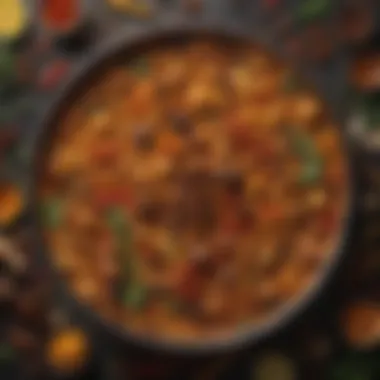

Intro
Curry cookbooks represent a critical aspect of culinary art, providing insights into a vast array of flavors and cooking techniques. They not only showcase recipes, but they also present the cultural and historical significance behind each dish. As the popularity of curry continues to rise globally, understanding the roots and variations becomes essential. This section introduces the complexities of curry, exploring how cookbooks serve as a bridge between tradition and modern culinary practices.
The diversity of curry dishes reflects the myriad of regional influences and ingredients. Each cookbook offers a unique perspective, illuminating the distinct flavors of regions such as India, Thailand, and the Caribbean. From aromatic spices to methodical preparation techniques, curry cookbooks serve as invaluable resources for both budding chefs and seasoned culinary enthusiasts.
Furthermore, selecting the right cookbook can elevate one’s cooking from basic to exceptional. It is important to assess your own cooking skills and dietary preferences. Whether you are a novice or an expert, the ideal book can unlock a treasure trove of culinary secrets.
Ultimately, the goal of this guide is to provide food lovers with comprehensive insights into various curry cookbooks, enabling them to explore and experiment with this rich culinary tradition.
Understanding Curry: A Culinary Overview
Understanding the culinary art of curry is essential for anyone looking to explore its rich and diverse flavors. Curry is not just a dish; it is a reflection of culture, history, and tradition across many regions. This overview will guide the reader through the essential elements that define curry, its historical developments, its presence in various cultures, and the common ingredients that form its backbone. To truly appreciate curry cookbooks, one must first grasp what curry represents within the culinary landscape.
Historical Context of Curry
Curry has a long and complex history that dates back to ancient times. The origins of curry are often linked to the Indian subcontinent, where it was first documented in texts around 500 BC. As trade routes expanded, spices traveled to various parts of the world, influencing local cuisines and adapting to different palates. The colonial period further accelerated this exchange, leading to the creation of hybrid dishes in countries such as England and Malaysia.
The word "curry" itself is derived from the Tamil word "kari," which refers to sauce or relish for rice.
This historical backdrop provides context and depth to the recipes found in curry cookbooks. Knowing how cultural interactions shaped curry helps readers appreciate the recipes and adapt them in their kitchens.
Curry Across Different Cultures
Curry is not a singular entity; it varies significantly from region to region. Each culture has infused its traditions and local ingredients into the concept of curry. For example, Indian curries often emphasize a variety of spices like cumin, coriander, and turmeric, leading to rich and aromatic dishes. In Thai cuisine, curries benefit from the use of coconut milk and fresh herbs, resulting in lighter and more fragrant flavors. Similar adaptations can be seen in Caribbean cuisine, where curry is often paired with local produce like sweet potatoes and plantains. Each cultural interpretation of curry merits exploration, as it adds depth to any culinary journey.
Common Ingredients in Curry Recipes
Understanding the common ingredients found in curry recipes is key to grasping how to create authentic flavors at home. While specific ingredients vary by region, some staples remain consistent across many types of curry. These include:
- Spices: These are the backbone of any curry, with spices such as turmeric, cumin, coriander, and garam masala being essential.
- Aromatics: Onions, garlic, and ginger are frequently used, creating the foundational flavor base.
- Proteins: Many recipes feature meat, poultry, or seafood, while plant-based proteins like lentils and chickpeas cater to vegans.
- Vegetables: A variety of vegetables, like bell peppers and spinach, often find their way into curries, offering nutrition and flavor.
- Liquids: Coconut milk or broth are key components in many recipes, adding richness and depth.
In summary, understanding the historical context, variations across cultures, and common ingredients of curry enriches our approach to using cookbooks. By recognizing these elements, readers will be better equipped to appreciate the art of curry cooking, leading to a deeper culinary adventure.
The Significance of Curry Cookbooks
Curry cookbooks hold a vital place in the culinary landscape, particularly in the realm of global cuisine. Their significance lies not only in their ability to offer recipes but also in their role as cultural bridges. They connect different culinary traditions and foster an appreciation for the varied flavors that curries can present. Understanding this significance can greatly enhance both home cooking and the overall culinary experience.
Why Use a Cookbook for Curry?
Cookbooks serve as valuable resources for both novices and seasoned cooks when exploring the art of curry. They provide structured guidance, ensuring that the complex layering of spices and techniques is accessible. A well-organized cookbook presents recipes that range from simple to intricate, allowing readers to progress through their culinary journey at their own pace.
Furthermore, cookbooks emphasize the importance of precision in measurements and cooking times, two factors essential for creating balanced flavors. They often include tips on cooking methods, which can be pivotal for achieving the right texture and taste in curries. For individuals seeking a structured learning approach, these cookbooks represent a foundational tool.
Developing Authentic Flavors
Authenticity in cooking is a crucial element, especially when it comes to curry. Many cookbooks shine in their ability to guide readers towards authentic flavors through the inclusion of traditional recipes, spice mixtures, and preparation techniques passed down through generations. For example, a cookbook focused on Indian curries might delve into the art of making garam masala from scratch, emphasizing the freshness of a homemade blend.
Moreover, they often highlight regional variations and the significance of specific ingredients, which contribute to the unique profiles of different curries. This acknowledgment of authenticity not only enriches the cooking process but also cultivates an understanding of the cultural context behind each dish. Readers can bring a piece of history and tradition into their kitchens.
Skill Development Through Cookbooks
Skill development is one of the more overlooked aspects of using cookbooks, particularly with intricate cuisines like curry. Through repeated practice of the recipes provided, individuals can refine their cooking skills significantly. Many cookbooks are structured in a way that gradually increases complexity, allowing cooks to build confidence along the way.
Beyond basic recipes, a good curry cookbook will teach essential techniques, such as how to properly toast spices or achieve the perfect simmer for a sauce.
Additionally, many cookbooks include detailed visuals and step-by-step instructions which can further support skill acquisition. Whether one is learning to balance flavors or mastering the timing between different cooking stages, curry cookbooks are instrumental in evolving a cook's capabilities.
Types of Curry Cookbooks

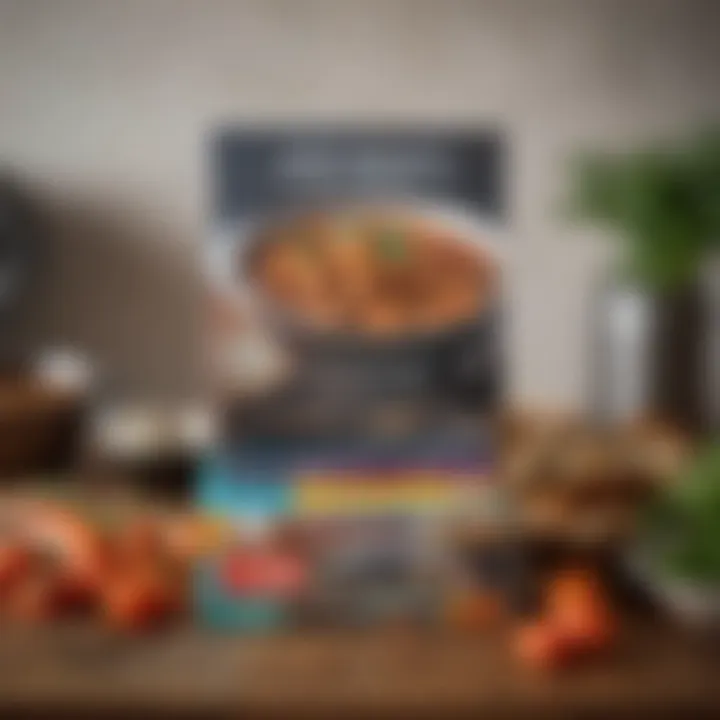
Understanding the various types of curry cookbooks is crucial for any culinary adventure centered on this diverse and flavorful dish. Each category of cookbook offers unique insights, techniques, and recipes that cater to different tastes and dietary needs. By exploring these categories, readers can find the ideal resources that align with their cooking style and skill level. This section will delve into both regional cookbooks that promote authenticity and specialized cookbooks that cater to specific diets.
Regional Curry Cookbooks
Indian Curry Cookbooks
Indian curry cookbooks are often regarded as a cornerstone in the world of curry. They showcase a rich variety of recipes that reflect the vast cultural and regional diversity found in India. A key characteristic of Indian cookbooks is their detailed use of spices. Spices such as cumin, coriander, and turmeric are essential to creating robust flavors. These cookbooks can be a beneficial choice for those seeking to explore the intricacies of traditional Indian cuisine.
One unique feature of Indian curry cookbooks is their emphasis on regional variations. For instance, a recipe from North India may significantly differ from one in South India, highlighting specific ingredients that might not be found everywhere. However, they can sometimes be challenging for novices due to the complexity and number of ingredients. Understanding these variances can greatly enhance one's culinary skills and appreciation for Indian cuisines.
Thai Curry Cookbooks
Thai curry cookbooks bring another vibrant perspective to the table. They focus on the harmonious balance between sweet, sour, salty, and spicy flavors characteristic of Thai cuisine. A defining aspect of Thai cookbooks is their emphasis on fresh herbs, like cilantro and basil, which contribute to the lightness typical of these dishes. This can be particularly beneficial for those who appreciate a more aromatic and less heavy approach to curry.
The unique aspect of Thai curry cookbooks is the inclusion of easily accessible ingredients. Many recipes can be adapted to suit what one might find in local markets, making them relatively easy to follow. Nevertheless, some readers may find the reliance on specific Thai pastes challenging to replicate outside Thailand, potentially limiting their use.
Caribbean Curry Cookbooks
Caribbean curry cookbooks introduce a lively mix of flavors and ingredients influenced by the islands' diverse cultures. They highlight the use of tropical ingredients, such as coconut milk and fresh fish, which set Caribbean curries apart from those found in Asian or Indian kitchens. This characteristic makes them a popular choice for those looking to explore new culinary territory.
A unique feature of Caribbean curry cookbooks is their use of fusion recipes. They often incorporate local traditions with Indian cooking techniques due to historical connections. This means that home cooks can expect a rich flavor profile that is different yet reflective of curry's global evolution. However, the availability of certain specialty ingredients can be a drawback, making it challenging for some to recreate these dishes fully.
Cookbooks for Specific Diets
Vegan Curry Cookbooks
Vegan curry cookbooks focus on plant-based ingredients, offering recipes that align with a vegan lifestyle. They emphasize the use of vegetables, legumes, and alternative dairy, making them suitable for those who choose to avoid animal products. A distinctive feature of these cookbooks is their ability to introduce flavors without relying on meat, showcasing the versatility of plant-based cooking. This makes vegan curry cookbooks a beneficial resource for any health-conscious individual.
However, some readers may find the absence of traditional flavors challenging to navigate, as recreating the depth that meat provides can be tricky.
Gluten-Free Curry Cookbooks
Gluten-free curry cookbooks cater to a niche but essential diet. They focus on ensuring that all recipes are free from gluten, making them accessible to those with celiac disease or gluten intolerance. A highlight of these cookbooks is their straightforward approach to modifying traditional recipes without losing taste. Many times, they swap out gluten-containing products for alternatives like rice flour or coconut flour.
Nonetheless, gluten-free cookbooks sometimes miss out on certain textures and flavors found in traditional recipes. Understanding how to enhance these nuances can aid in achieving more satisfying results.
Low-Carb Curry Cookbooks
Low-carb curry cookbooks target those looking to reduce carbohydrate intake. These cookbooks feature recipes designed to replace high-carb ingredients with lower-carb alternatives while still preserving the essence of the curry experience. A key characteristic is the focus on protein and vegetables, appealing to health-minded readers.
The unique advantage of low-carb cookbooks lies in achieving a satisfying meal without the carbohydrate load typical of many curries. However, some may find the changes in ingredients lead to a variation in flavor, requiring an adjustment period for tastes.
Cookbooks for Beginners vs. Experts
Differentiating between cookbooks for beginners and experts is essential for a successful cooking journey. Beginners often need step-by-step guidance and simplified recipes, while experts may seek complex techniques and intricate flavors. Ultimately, the type of cookbook chosen should align with the cook's current skills and aspirations, ensuring that the culinary experience remains enjoyable.
Key Considerations When Choosing a Curry Cookbook
When diving into the realm of curries, selecting the right cookbook can determine the success of your culinary journey. The right resource can provide clarity, inspire creativity, and enhance your understanding of this diverse cuisine. Thus, several key considerations must guide this choice, ensuring that the cookbook aligns well with your skills, preferences, and aspirations.
Assessing Personal Skill Level
Understanding your own cooking skill level is crucial when choosing a curry cookbook. Beginners might benefit from collections that offer simple recipes and essential cooking techniques. Books by authors like Meera Sodha provide straightforward instructions and relatable ingredients. In contrast, more experienced cooks may look for cookbooks that challenge their knowledge, such as The Curry Guy by Dan Toombs, which explores intricate recipes and techniques.
To effectively assess your skill level, consider the following:
- Self-Reflection: Identify your comfort zone in the kitchen. Can you confidently handle spices and temperatures?
- Past Experiences: Reflect on previous attempts to cook curries. Were they successful, or did you struggle?
- Peer Comparison: Look at others' cooking levels. Are you among beginners or are you more advanced?
Understanding Recipe Complexity
Recipe complexity can vary significantly from one curry cookbook to another. Some books emphasize simplicity, while others engage deeply with traditional methods. Understanding this complexity helps you prepare for what to expect. For example, Indian-ish by Priya Krishna simplifies popular Indian dishes, making them accessible without losing authenticity.
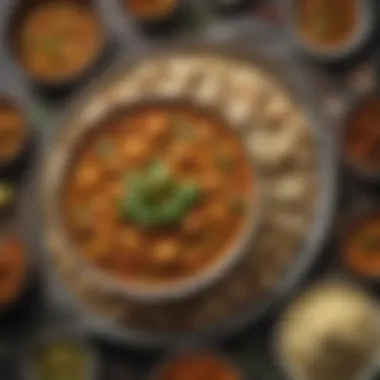
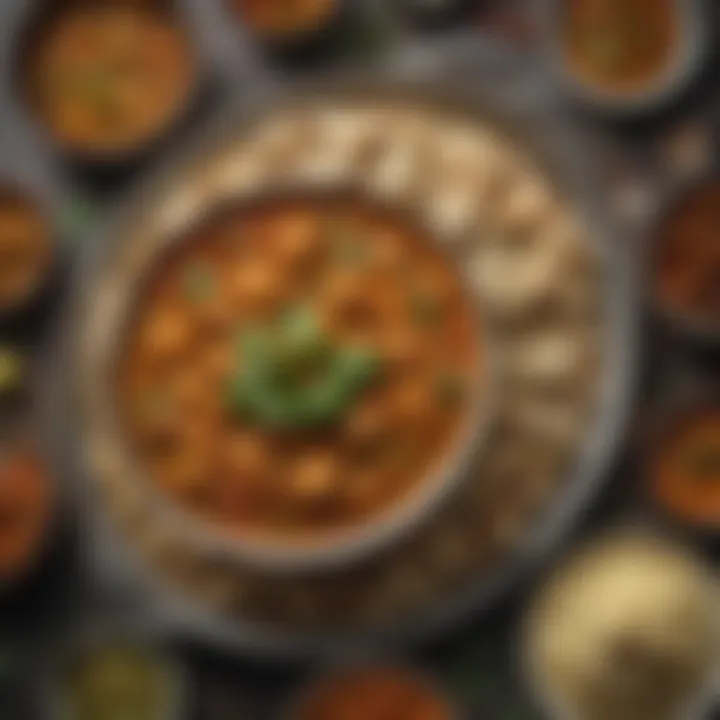
On the contrary, a cookbook like The Spice Box explores regional ingredients and subtleties, which may require more advanced techniques. When evaluating recipes, think about:
- Ingredient Requirements: Are the ingredients commonly found within your region?
- Preparation Time: Does the recipe fit your schedule? Some curries can take hours, while others can be done in 30 minutes.
- Cooking Techniques: Are the methods you need to use within your skill set?
Ingredient Accessibility
Ingredient accessibility is a key factor in successful curry cooking. The ability to find and source ingredients directly impacts the quality of your curry dishes. Some cookbooks rely heavily on exotic spices or unique ingredients that may not be readily available. For instance, Persiana by Sabrina Ghayour showcases Middle Eastern flavors but may require specialty ingredients, which could pose challenges for novice chefs.
To ensure successful cooking, consider the following when evaluating ingredient accessibility:
- Local Availability: Check if you can find crucial spices at local markets or online.
- Substitutes: Does the cookbook provide alternative ingredients when certain items are difficult to obtain?
- Seasonal Aspects: Are there specific seasons for ingredients that may affect your cravings and desire to cook certain dishes?
Choosing the right curry cookbook is an essential step in developing your culinary skills and expanding your palate. By considering your skill level, the complexity of the recipes, and ingredient accessibility, you can navigate the myriad of options available and find a cookbook that suits your unique journey into the world of curries.
Essential Techniques for Cooking Curry
Curry cooking requires an understanding of both ingredients and techniques. Mastering these methods enhances not only the flavor but also the overall experience of preparing and enjoying curry. This section elaborates on key techniques that are significant to curry preparation and showcases how they contribute to achieving optimal results in flavor and texture.
Mastering Spice Blends
Spices form the heart of any curry dish. Their proper use can elevate a simple recipe to extraordinary heights. Mastering spice blends is essential for achieving depth in flavor. Common spices include cumin, coriander, turmeric, and fenugreek. Whether creating a garam masala or from scratch spice mix, knowing the balance is crucial.
Creating the right blend involves understanding the profile of each spice. For instance, cumin offers a warm, earthy base, while coriander imparts a citrus-like note. This balance is key. Experimenting with proportions can lead to personalized recipes, refining your palate over time.
"A well-prepared spice blend is like a symphony—every note matters."
Cooking Methods: Simmering vs. Sautéing
The cooking method significantly affects the final outcome of the curry. Sautéing typically allows for a more immediate release of flavors. In this approach, spices are cooked in oil first, which can enhance their essential oils, leading to a richer taste.
On the other hand, simmering is more about melding flavors over a longer period. It allows for ingredients to soften and reflects a more integrated flavor profile. This method is especially beneficial for dishes with meats or vegetables, where tenderization is required.
Both methods serve distinct purposes:
- Sautéing: Quick flavor enhancement
- Simmering: Deep, complex flavor development
Understanding when to employ each technique will broaden your culinary skills and enhance your dishes.
Pairing Curries with Accompaniments
A well-made curry stands out, but its enjoyment can be greatly enhanced through careful pairing with accompaniments. Common side dishes include rice, naan, or yogurt-based condiments like raita. Each has a role, balancing the heat and spices of the curry.
Rice absorbs flavors and adds texture:
- Basmati Rice: Aromatic and fluffy, ideal for Indian curries
- Jasmine Rice: Slightly sticky texture, pairs well with Thai coconut curries
Naan provides a delightful contrast, adding chewiness and warmth, perfect for scooping up curry. Raita cools the palate, countering spice intensity.
Featured Curry Cookbooks
Featured curry cookbooks hold a special place in the culinary landscape. They serve not only as manuals for cooking but also as resources that encapsulate the diverse and rich tradition of curry. Selecting the right cookbook can enhance one’s cooking skills, leading to a deeper understanding of flavors, ingredients, and techniques. This section emphasizes the importance of identified works that have stood the test of time or have brought fresh perspectives into the curry realm.
Classic Curry Cookbooks
Classic curry cookbooks are vital for anyone looking to understand the foundational techniques of curry-making. These books often highlight traditional recipes passed down through generations. Titles such as "The Complete Indian Cookbook" by Julie Sahni serve as references for authentic Indian curry recipes. They typically emphasize age-old cooking methods and ingredients, crucial for developing traditional flavors.
Among the benefits of classic cookbooks, readers can find clear instructions and well-annotated ingredients lists. They often explore regional variations, allowing cooks to appreciate the nuances between different styles. Also, they often include historical anecdotes that can enhance the overall understanding of curry's significance in a culture.
Modern Takes on Curry

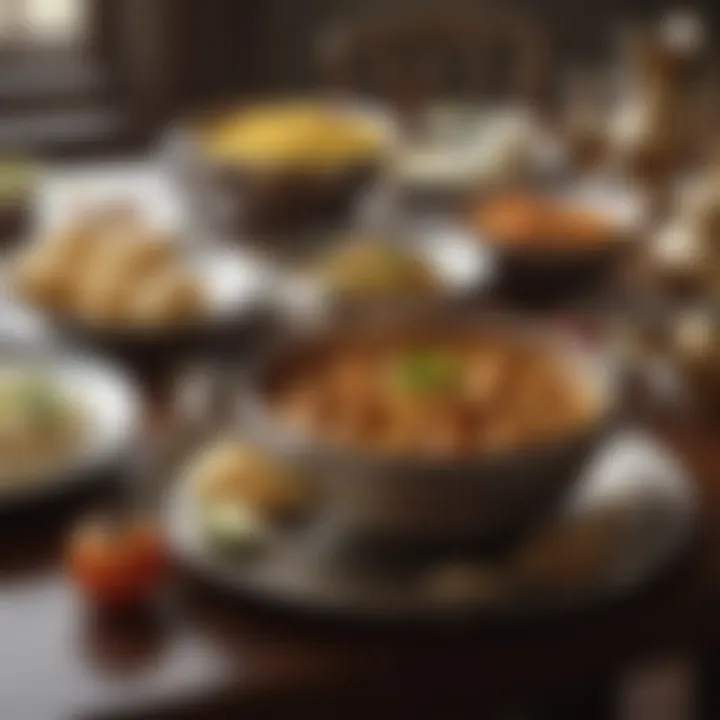
Modern takes on curry reflect a shift in cooking paradigms. These cookbooks often blend traditional recipes with contemporary techniques or fusion elements. For example, "Indian-ish: Recipes and Antics from a Modern American Family" by Priya Krishna offers a fresh perspective by intertwining Indian flavors with American culinary practices. This genre appeals to a younger demographic interested in accessibility and innovation in cooking.
In these cookbooks, you may find simplified instructions and shortcuts, making it easier to replicate complex dishes. They often highlight health-conscious alternatives or ingredient swaps, aligning with current lifestyle trends. With a focus on visual appeal, these cookbooks also engage readers through vibrant photography, enhancing the overall cooking experience.
Cookbooks from Culinary Influencers
Cookbooks from culinary influencers reflect the democratization of cooking and food publishing. Influencers like Yasmin Khan with her book "Zaitoun: Recipes from the Palestinian Kitchen" have gained recognition for sharing culturally rich recipes that may not have received ample attention in mainstream publishing.
These cookbooks often come with a unique narrative voice, presenting personal stories and connections to recipes. They also leverage social media platforms to gather feedback and adapt recipes based on community input. This interactive factor can enrich the cooking experience, providing readers insights into modern culinary practices.
Moreover, influencer cookbooks tend to include tutorials and tips that cater to novice cooks, enhancing the learning curve. Readers can also expect diverse recipes that accommodate various dietary needs, making them versatile for everyday cooking.
Choosing the right cookbook can redefine your culinary journey. Whether you opt for a classic or modern perspective, each has its own value.
Tips for Expanding Your Curry Knowledge
Expanding one's knowledge of curry is essential for anyone interested in deepening their culinary skills. Curries are not merely dishes; they embody cultural histories and diverse cooking techniques. Each region brings its own spice elements and flavor profiles, making understanding these nuances a rewarding endeavor. Through this section, various methods to enhance your knowledge of curry will be explored. These approaches are not just about learning recipes but also about appreciating the cultural backbone and variety found within curry cooking.
Experimenting with Ingredients
One significant way to enhance your curry experience is by experimenting with ingredients. Curry allows for a broad spectrum of creativity. While traditional recipes are a great starting point, modifying them can lead to unique flavors and styles.
Consider trying different types of spices, vegetables, or proteins. For example, replacing chicken with a vegetarian option can offer a different texture and taste. Alternatively, using alternative spices like smoked paprika or star anise can alter the entire dish profile.
This experimentation can extend beyond the base ingredients. Introducing exotic elements, such as fresh herbs or unusual legumes, can infuse freshness and surprise into your curry.
Attending Cooking Classes
Attending cooking classes dedicated to curry is another beneficial approach. These classes often provide hands-on experience, enabling you to learn techniques directly from experienced chefs. Moreover, classes often foster a community atmosphere, encouraging the sharing of tips and personal experiences.
Classes can vary significantly — from focusing on a specific regional style, such as Indian or Thai, to exploring modern interpretations of classic recipes. Enrolling in a class can deepen your understanding of cooking principles, help you develop essential skills, and inspire creative freedom in your kitchen.
Engaging with Culinary Communities
Engaging with culinary communities enhances your curry knowledge and offers valuable connections to fellow enthusiasts. Platforms like Reddit, Facebook, and food blogs can serve as resources where you can share experiences and gather insights. Joining groups specifically focused on curry can lead to discussions about unique recipes, cooking techniques, and ingredient sourcing.
Participating in food forums also provides exposure to various cooking styles and cultural understandings of curry. You will gain from the wealth of knowledge that fellow cooks have to share, and even discover local or online events such as potlucks or cooking competitions.
In summary, expanding your curry knowledge involves a multi-pronged approach. By experimenting with ingredients, attending cooking classes, and engaging with culinary communities, you cultivate a deeper understanding of this vibrant dish. This not only enhances your culinary skills but also fosters a wider appreciation for the cultural richness that curries represent.
The Future of Curry Cookbooks
In this era of culinary exploration, the future of curry cookbooks holds significant relevance. As globalization makes diverse cuisines more accessible, curry continues to evolvedl as a beloved dish around the world. The forthcoming trends not only reflect changing tastes but also the integration of technology in cooking.
Emerging Trends in Curry Cooking
Curry cooking is seeing a shift that mirrors broader food trends. People are increasingly interested in health-conscious cooking, which influences recipe choice. Here are some notable trends:
- Health-focused ingredients: There’s growth in the use of organic, locally sourced, and nutrient-dense ingredients. More cookbooks now emphasize the use of superfoods within traditional curry recipes, enhancing flavor without compromising health.
- Fusion and experimentation: More chefs experiment with fusion curries, merging flavors from various cuisines. This creativity encourages home cooks to try innovative combinations, enriching their culinary repertoire.
- Sustainable practices: As awareness of environmental issues grows, many cookbooks emphasize sustainable cooking. This includes reducing waste and selecting ingredients that are both delicious and environmentally friendly.
The Role of Digital Cookbooks
Digital cookbooks play an increasingly vital role in the future of culinary exploration, especially when it comes to curry. E-books and apps offer unique advantages:
- Interactive elements: Many digital cookbooks include videos or animations. This engaging approach can provide clearer guidance on techniques and ingredients.
- Easy updates: Recipes and cooking trends can shift rapidly. Digital formats allow authors to update content easily, ensuring readers have the latest information.
- Accessibility and searchability: Digital cookbooks are searchable. This feature allows users to quickly find recipes based on specific ingredients or dietary needs.
Curry Cookbooks in Popular Culture
Curry cookbooks are increasingly woven into popular culture, reflecting the dish's growing prominence. This influence is observed in various media:
- Celebrity chefs: Many television personalities and chefs, such as Jamie Oliver and Madhur Jaffrey, have increased the visibility of curry through their cookbooks and cooking shows. Their popularity helps translate traditional recipes into modern, accessible instructions.
- Social media: Platforms like Instagram and TikTok showcase home cooks experimenting with curry recipes, fostering community among enthusiasts. This shared passion further increases the demand for diverse curry cookbooks.
"The future of curry cookbooks isn’t just about recipes, but also about creating an engaging, interactive, and accessible culinary experience."
Curry cookbooks are set to evolve with these trends, blending tradition with modern preferences and making the rich world of curry more accessible to diverse audiences.







